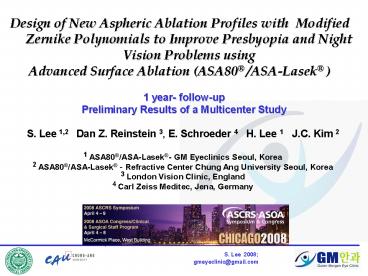Zernike - PowerPoint PPT Presentation
Title:
Zernike
Description:
3 London Vision Clinic, England. 4 Carl Zeiss Meditec, Jena, Germany ... Kruskal-Wallis-Test (p 0.05) Advanced Surface Ablation (ASA80 / ASA-Lasek ) in all cases ... – PowerPoint PPT presentation
Number of Views:235
Avg rating:3.0/5.0
Title: Zernike
1
Design of New Aspheric Ablation Profiles with
Modified Zernike Polynomials to Improve
Presbyopia and Night Vision Problems
using Advanced Surface Ablation (ASA80
/ASA-Lasek )
1 year- follow-up Preliminary Results of a
Multicenter Study
S. Lee 1,2 Dan Z. Reinstein 3, E. Schroeder 4
H. Lee 1 J.C. Kim 2 1 ASA80/ASA-Lasek- GM
Eyeclinics Seoul, Korea 2 ASA80/ASA-Lasek -
Refractive Center Chung Ang University Seoul,
Korea 3 London Vision Clinic, England 4 Carl
Zeiss Meditec, Jena, Germany
2
- Study Design
- Prospective multi-center clinical trial (between
01/2006 and 01/2008) - Total of 43 eyes of 26 consecutive patients Age
(mean) 34.37 6.18 years - All eyes treated with Individual New Aspheric
Customized Ablation Profiles (NAP) by adding a
shotfile with a negative spherical aberration
Z4(0) to shift the spherical aberration into the
plus range - Mean Spherical Equivalent (MRSE)
- Myopia - 6.32D 2.65 D (Myopia -0.75D to
-14.75D - Astigmatism -0.50D to -6.00D
- Hyperopia 2.49D 1.45 D (Hyperopia
0.75D to 4.00D - Astigmatism -0.50D to -6.00D)
- Add requirement (mean) 1.98D 0.41D ( Near
Vision lt Nieden 4 ) - All eyes treated with the MEL-80 Spotscanning
Excimer Laser (Carl Zeiss Meditec, Jena, Germany)
3
- Advanced Surface Ablation (ASA80 / ASA-Lasek
) in all cases
- MEL80 Ablation Profiles
- TSA (Tissue Saving Ablation) Type
Munnerlyn-profile with k-value compensation - ASA (Aberration Smart Ablation) Type TSA plus
aspheric component - NAP New-individual-Aspheric-ablation-Profiles
ASA Z(4,0) ? Addition of negative spherical
aberration ?
- Statistical Analyses SPSS v.15.0
- All tests used were non-parametric, based on
Kolmogorov- Smirnov-Test - no parametric t-test for significance instead
Wilcoxon, Mann-Whitney-U, - Kruskal-Wallis-Test (plt 0.05)
4
Clinical Results
Gain of 4.5 lines in Nieden (72)
5
p lt.05
p lt.05
postop lt preop (p gt.05)
9 (plt.05)
6
- Case Reports
- Myopic Patients
- Z(4,0) vs Pupil Diameter
- Depth of Focus
- Control of Refraction vs
- Pupil Diameter
ASA-Profile
7
ASA Z(4,0)
Patient hyperopic (overcorrected) under bright
daylight and mesopic condition
8
ASA Z(4,0)
Patient myopic (undercorrected) under bright
daylight and mesopic condition
9
ASA Z(4,0)
positive
- Patient
- myopic under bright
- daylight and
- plano under mesopic
- condition
Ideal outcome!
10
Design of Refraction vs Pupil Diameter
Bright Light Vision
Mesopic Vision
Bright Light Vision
Mesopic Vision
Myosis
Myosis
11
(No Transcript)
12
Summary
Customized correction of spherical aberrations
improve contrast sensitivity, mesopic contrast
sensitivity and especially near vision and
reduces presbyopia in myopic, hyperopic and even
in high myopic and hyperopic cases
Conclusion
Perfect design of an ablation profile with a
negative spherical aberration for presbyopic eyes
should
increase depth of focus for far vision
set bright light refraction below plano (around
0.75 D)
avoid inducing night myopia, have mesopic
refraction around plano































